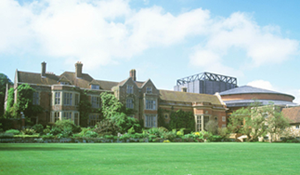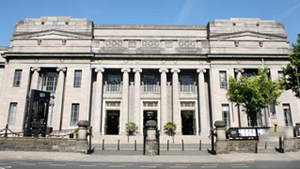
Early Years in Athlone
Louis was born August 6th 1931 in Athlone, Co. Westmeath Ireland. He attended the Marist Brothers College in Athlone, the very same school Count John McCormack attended years previously. His first venture into singing came when singing "The Old House" in a school concert followed by leading roles in Wallace's Maritana and Gilbert and Sullivan's Trial by Jury. At 12 years of age he made his debut on Radio Éireann singing Schubert's "Ave Maria" and "My Singing Bird". In addition before his voice broke at age 14 he recorded "Hear My Prayer" and "O For the Wings of a Dove" at Peter Hunt's studios in Greystones, Co. Wicklow 3. Before traveling further afield Louis sang leading roles with the Athlone Musical Society and went on to win the tenor gold medal at the Fr. Mathews Feis.

1950's Dublin
At age 19 Louis moved to Dublin to continue his studies at the Municipal School of Music with Michael O'Higgins. While in Dublin he entered the Feis Ceoil and walked away with the gold medal for "Tenor Solo" just as John McCormack had done many years earlier. Louis quickly gained notoriety as a talented singer and was selected as one of the Feis Éireann "Irish Festival Singers" for a four month tour of 42 states of the USA and Canada (1956). Later in the same year he joined the Rathmines & Rathgar Musical Society, singing Fairfax in the society's 100th performance of Gilbert and Sullivan's Yeomen of the Guard. Increasingly Louis was invited to perform in a range of concerts including Haydn's oratorio The Seasons with the St. James's Gate Musical Society, also various radio engagements with the Radio Éireann Light Orchestra and the National Symphony Orchestra 1.
The Guildhall & Glyndebourne
Norman Meadmore, an English guest producer with the Dublin
musical society noticed Louis' talent. Meadmore formerly of
the D'Oly Carte Company in England arranged for an audition
for him at the Guildhall
School of Music and Drama. The audition resulted in Louis
being offered a full scholarship to study with Arthur Reckless
at the Guildhall from 1957-1959 2.

It was an exciting time at the Guildhall with talents such as Benjamin Luxon, Donald McIntyre, Delme Bryn Jones and cellist Jacqueline du Pré in attendance at the same time 3. As a student he was involved in various Guildhall productions (Fenton in Verdi's Falstaff, Cavaradossi in Tosca and Don Basilio in Mozart's The Marriage of Figaro).
Following his studies in 1960 he auditioned successfully for the Glyndebourne Festival Opera with Jani Strasser as head of music. Louis started as a chorus member under chorus master Peter Gellhorn. The chorus was made up of very talented young singers including Ann Howells, Ryland Davies, Elizabeth Harewood and Francis Egerton 3. The aspiring singer soon was offered understudy parts including the Italian Tenor in Strauss's Capriccio. Invited back for a second season he performed in various cameo tenor roles 2.
In 1959 Sadler's Wells Theatre hosted the "New Opera Workshop" for the first performance of "The Sofa" an Opera in one act by Elizabeth Maconchy" in which Louis was invited to sing.
English National Opera (Sadler's Wells) (1961-1973)

Although frequently called upon to sing Rossini; Louis sang in a diverse range of operas including Carmen, The Bartered Bride, Faust, La Traviata and Wagner's Die Meistersinger von Nürnberg. As a diversion form grand opera the company also staged productions of a number of operettas by Lehár, Johann Strauss and Gilbert & Sullivan.
Touring was part of the commitment at Sadler's Wells from Bournemouth to Bradford, Glasgow, Aberdeen, Leeds, Liverpool, Manchester Birmingham, Norwich, Sheffield, Wolverhampton, Cardiff, Bristol Brighton, Oxford, Cambridge, Belfast, Hamburg, Stuttgart and Brussels.
Outside the company's season he sang the title roles in Faust and Le Comte Ory for Neath Opera group during one of its summer seasons at the Adelina Patti Theatre Craig Y Nos. Also singing oratorio, Rossini's Stabat Mater and Verdi's Requiem with the Liverpool Philharmonic. In Ireland he was heard in 1963 in Fleischmann's The Fountain of Magic, in 1970 in Dvořák's Requiem and in 1971 in Kodály's Psalmus hungaricus 1. In 1973 he sung the role of Jenik in The Bartered Bride in a production by Opera North.
Louis enjoyed the camaraderie working with colleagues such as Denis Dowling, Harold Blackburn, Derek Hammond-Stroud, Patricia Kern and Howell Glynne 3 but knew it was time to move on and pursue other attractive offers outside the company.
Solo Career (1973)
After leaving the opera, Louis pursued his career as a solo
artist, singing in grand opera, operetta, oratorio and in
concert performances for radio and television. His many radio
broadcasts include Friday Night is Music Night, Grand
Hotel, Invitation to Music, Music for You, The
Tale of Two Cities Opera, Sound of Light, Music
of the Nation and The Sam Costa Show on the B.B.C. His
television work included appearances as tenor soloist in Melodies
For You and Music for You on the B.B.C. and the role
of Count Almaviva in the Barber of Seville for Scottish
T.V. He also sung on The Bing Crosby Show in the USA
and various programs for RTÉ.

In 1984 he toured Ireland with Irish National Opera in a production of La Traviata.1 Other performances include Tippett's A Child of Our Time (1977) and Rachmaninoff's The Bells (1986) 1.
His career lead him to sing with some of the great artists of his era including sopranos Dame Joan Sutherland and Victoria de los Ángeles. Louis also worked with the prestigious conducting talents of Sir Colin Davis, Sir Charles Groves, Sir Charles McCarins and Sir Alexander Gibson.
Tours of America & Britain
Travels to the U.S.A. became an annual affair, traveling on tours with Paddy Noonan and Hal Roache across America singing Irish ballads and concert favourites.
He performed in Gilbert and Sullivan on transatlantic crossings on the QE2 and cruises from New York to the Bahamas and Bermuda.
Across England Summer shows included performances in Bournemouth, Cromer, Folkestown, Skegness and Blackpool including Chariman of Those Good Old days twice nightly there.
Returning Home to Ireland
In the late 70's, now married with a son and daughter, Louis alternated living between London and Killarney Co. Kerry. In 1981 he moved back permanently to Killarney, then later to Dublin and eventually to Waterford City.
In Ireland he was engaged with Eamonn Andrews Studios in Killarney, Jury's Irish Caberet and Gales of Laughter with Maureen Potter at the Gaiety for two seasons.
Louis had a special flair for operetta and was a guest tenor with most of the light opera companies in Ireland, in particular, the Rathmines & Rathgar, Athlone Musical Society, and Glasnevin Musical Society.
Together with Peter McBrien, he founded Irish Concert Artists to promote recitals at the National Concert Hall of Irish singers working abroad (1986-9) 1. Also at the NCH, from 1999 to 2004, Louis along with Patrick Healy of the English Nation Opera presented the annual event The World of Gilbert and Sullivan. Other presentations at the NCH included A Viennese and Italian Evening, A World of Popular Song and a stage production of Tosca with guest stars Suzanne Murphy and Dennis O'Neill.
As he grew up in Athlone, an early and lasting influence on his singing was John McCormack, and he took part in several McCormack anniversary events in Ireland and England, including a Dublin play about McCormack's life, Lovesong by G.P. Gallivan, in March 1984. His commercial recording activity was mainly devoted to McCormack's Irish ballad repertoire, starting with his first LP in 1960. In 1997 he received the John McCormack Award from the Vocal Heritage Society of Ireland for his contribution to the vocal arts 1.
Discography
- The Fairest of Them All - Orchestra directed by Kitty O'Callaghan - Emerald Records - 1960
- Beloved Catholic Hymns - Accompanied by Norman Metcalfe Organ - Avoca Records - c1960s
- Louis Browne Recalls - Accompanied by Patrick Healy Piano - REX records - 1978
- From the Isle of The Quiet Man - Accompanied by Patrick Healy Piano - Rego Irish Records - 1979
- An Evening in Ireland - Orchestra conducted by Noel Kelehan - Rego Irish Records - 1982
- Sweet Vale of Avoca: The Meeting of the Waters - Chart Records - c1986
- Irish Tenor Favorites - Orchestra conducted by Noel Kelhan - Rego Colleen - 1993
References
- "Encyclopaedia of Music in Ireland", edited by Harry White and Barra Boydell, published Dublin: UCD Press, 2013. Article by Axel Klein, Ph.D.
- "Irish Voices at Glyndebourne", by Gus Smith (Dublin, 2004).
- "Irish Stars of the Opera", by Gus Smith (Dublin, 1994).
